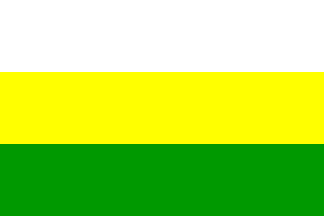
by Thanh-Tam Le , 12 Febuary 2000

Last modified: 2014-05-29 by zoltán horváth
Keywords: puerto rico | guayanilla | anchor | lion |
Links: FOTW homepage |
search |
disclaimer and copyright |
write us |
mirrors

by Thanh-Tam Le , 12 Febuary 2000
See also:
Other Sites:
This city of 21,996 inhabitantsit is in southwest Puerto Rico
and was founded on February 27, 1833. The colours of the flag
come from the CoA.
Thanh-Tâm Le, 12 January 1999
Guayanilla - The flag boasts the main shield colors. It is
made of three horizontal stripes of equal width: white the upper
one, yellow in the center, and green the lower one.
Blas Delgado, 14 April 2001
gl.gif)
by Nelson L. Román, 9 July 2004
From <www.linktopr.com>:
"The Coat of Arms consists of a quartered shield. The first
and fourth quarters contain in a green field a hermitage
accompanied with two houses, one on each side of the hermitage,
all in silver. The openings are highlighted in red. The hermitage
of the first quarter is accompanied by a silver star with eight
rays. The second and third quarters contain a silver field, with
a green lion. The lion of the second quarter holds in its right
hand a red flower. In the fourth, a lion holds in both hands a
red arrow pointing up. In the center resides a small red shield
with a five-pointed crown in gold. Below the small shield is
located a blue anchor. At the top a three-tower crown in gold,
outlined in black and the openings highlighted in green. The Coat
Of Arms may be placed between two sugar cane stems, with its two
green leaves crossed at the bottom and drawn in the conventional
heraldic way.
The hermitage and the houses represent a primitive Christian town
of Puerto Rico, specifically the one of Santa Maria de
Guadianilla or San Germán el Nuevo, that were was established in
the margins of the Guayanilla River, in the middle of the
sixteenth century. The star symbolizes Our Lady; La Inmaculada
Concepción, patron of the population, and the waved stripe, the
river. The repetition of this subject, without the star, in the
last quarter, alludes to the second foundation of Guayanilla, in
1833. The lion is taken, with alteration of its colors, from the
shield of Ortíz de Almendralejo, Extremadura, a region where Don
Rodrigo Ortíz Vélez came from, mayor and defender of Santa
Maria de Guadianilla, and founder of San Germán de las Lomas de
Santa Marta, a place where the primitive population was
transferred during 1570. It represents, in addition, the value
and the intrepidity whereupon Don Rodrigo and his men defended
the town against two attacks and attempts of invasion: One by
French Corsairs and another one by Caribbean Indians. The first
victory is symbolized by the lily flower and the second by the
arrow, which in this case represent the battles. The old crown,
in the small red shield in the center, represents Cacique
Agüeybaná, main monarch of the Tainos of Borinquen, whose
yucayeque was located in the Guianía region, where today
Guánica, Yauco and Guayanilla are located. The blue anchor in a
gold field, symbolizes the beach and the port of Guayanilla. The
crown is standard upon municipal shields and symbol of the unity
that must characterize the inhabitants of a population or
municipality united in its defense of its autonomy, conservation
of its historical traditions and promotion of the communal well
being. The sugar cane stems indicate that Guayanilla is located
in a sugar cane zone and the importance that the sugar industry
has had in the history of the town."
Nelson L. Román, 9 July 2004